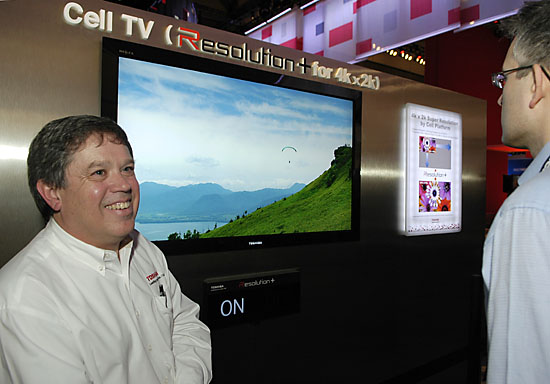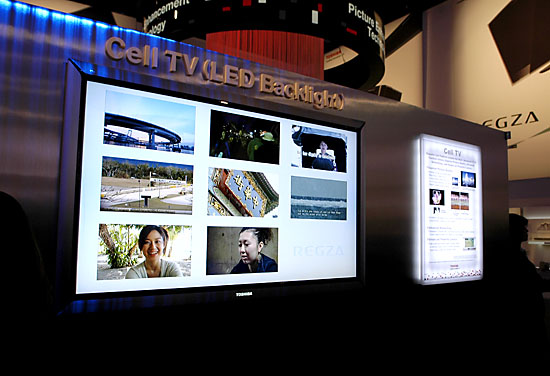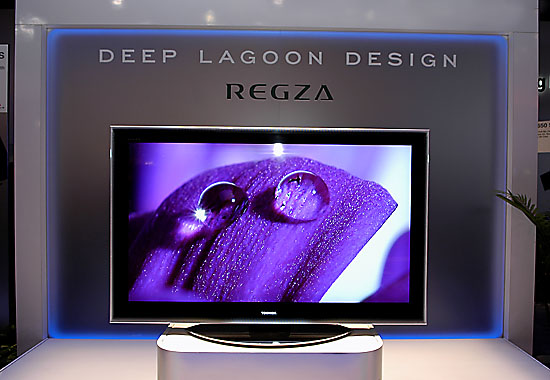CES 2009 - TV Trends, WirelessHD, 240Hz and Netbook Pricing
by Anand Lal Shimpi & Manveer Wasson on January 12, 2009 12:00 AM EST- Posted in
- Trade Shows
Toshiba Talks the Future of TVs
Toshiba was big on talking about the future of its LCD TVs at this year’s CES so we got a big tech demo of what’s to come.

Tosh was the only manufacturer to say that 4K x 2K panels will be the future of LCD TVs, the rest were far more focused on today’s 1080p displays. The name is a bit misleading as the actual panel resolution is 3840 x 2160 (or 2 * 1920 x 2 * 1080). Since it’s an even multiple of 1080p, upscaling 1080p content to a 4K panel isn’t difficult - so existing content should adapt well to it. While 4K displays are still a while away, as soon as there’s content to support it, we’ll start seeing them.

The 4K demo was done on Toshiba’s Cell powered TV. The Cell TV is powered by the same Cell processor that’s in Sony’s PlayStation 3, the difference being that here its used to drive the menu system and handles all upscaling of lower resolution content to the 4K panel. Additionally, the Cell processor runs the backlight dimming algorithm. The advantage here being that Cell is powerful enough to control more dimming zones than the Regza lineup’s current processor.

The Cell processor is also fast enough to decode 6 simultaneous HD streams at once. While you probably won’t watch six things at the same time, you could have a ridiculous picture in picture mode that’s very Back to the Future II-esque.
The rest of the technologies Toshiba talked about will be shipping on their 2009 model year Regza lineup.
Deep Lagoon is the name for Toshiba’s new bezel design. The idea is to make the panel and bezel seem as one. The bezel is black like the panel (but a more panel-like black) and is perforated as you get away from the panel to give it the appearance of fading away. The highest end Regza will have a bezel that is flush with the LCD panel.


Toshiba’s TVs will also include a technology called Dolby Volume. A modern take on a solution to an old problem: how to deal with watching content with different volumes. You know the case, you’re watching a TV show at a particular volume and are interrupted by a commercial that’s far too loud.
TVs have shipped with adaptive volume for quite some time, but Toshiba argues that the old solution wasn’t good. The old solution used to be to simply apply a low pass filter that would eliminate high frequency audio. You’d get the impression of lower volumes but at the expense of actually losing some of the audio.
Dolby Volume keeps all of the audio; it simply compresses the spectrum. Louder sounds get quieter and quieter sounds get louder, allowing you to listen at low to normal volumes without worrying about blowing out your ears if an inconsiderate commercial airs.
As is the case with all spectrum-compressing technologies, audio purists may want to opt out. Most of these sorts of technologies in TVs (including overboosting colors) tend to appeal to the users who aren’t as in tune with (or don’t care about) what things are intended to look/sound like. It’s the same reason that distorting 16:9 stretch modes are so popular despite what they do to peoples’ faces. Dolby Volume appears to be a better solution to the volume problem, but unless you dynamically adjust the volume on your TV set, compressing the spectrum isn’t going to be the most acoustically pure solution.
Toshiba is including an Expert Mode on its 2009 LCD TVs. Although we didn’t get any additional information, it sounded like an easily accessible service menu, giving end users the same access that a calibrator would have without the risk associated with modifying settings in the service menu. We’d hope that more TV manufacturers would expose service-menu settings in a safer environment for the enthusiast market.
Toshiba talked about a feature called Instaport. When you turn the TV on it will perform the HDCP handshaking with all HDMI devices that are connected and turned on, so that switching between the HDMI inputs on the TV is faster. Toshiba didn’t demo the technology and it’s only useful if you have a bunch of devices turned on all the time, but it’s an attempt at addressing an annoying problem with current TVs.
Another Toshiba-only tech topic was 14-bit color processing on its Regza TVs. The LCD themselves don’t use 14-bit panels, but all processing is done internally with 14-bit resolution and then downsampled upon output. There are situations where 14-bit internal precision could help reduce color banding but I’m guessing that more often than not you won’t notice a difference.










30 Comments
View All Comments
superandroid - Thursday, January 15, 2009 - link
i think that the 60 ghz microwave frequency will be hazardous to the human brain because it can easily penetrate the human body.3DoubleD - Thursday, January 15, 2009 - link
That is incorrect. 60 GHz cannot easily penetrate the human body, which would actually be more reason to fear it than if it could simply just pass through. However, 60 GHz photons have such little energy that they can't possibly negatively influence the human body, just like all other radio communication and microwaves. Now if the transmitter is powerful enough that the absorbed energy turns into a significant amount of heat (eg a microwave oven), then you should worry about cooking yourself. Considering a microwave oven is ~1000 Watts and this transmitter will likely be on the order of a few hundred or thousand milliwatts, you have nothing to fear.michael145 - Tuesday, January 13, 2009 - link
Man, imagine running Crysis at 4K's resolution with 4AA/4AF on...What machine do you need?
fly123 - Tuesday, January 13, 2009 - link
anybody know if this will be usable with a media server, or is the wirelesshd consortium locking it down to oem because of drm fear?I mean, do any of you know if there are any plans for making a plugin device that one can plug into a pc and screen of own chosing?
Ive looked at the consotiums website, but havnt been able to find anything usefull.
Milleman - Monday, January 12, 2009 - link
"Your inputs are connected wirelessly to the TV via a 60GHz signal..."That's a lot of Hertz. I didn't think 60 GHz was possible to produce with todays semiconductor technology.
Stampede103 - Monday, January 12, 2009 - link
Does any one know of a netbook that is using Nvidia's Tegra 600 line of processors?sprockkets - Monday, January 12, 2009 - link
When a netbook can play YouTube on the HQ setting without stuttering, I'll get one.I still like the HP one with the nice sized keyboard. If they used a Nano or Dual core Atom with Ion, this problem would be solved.
Denithor - Monday, January 12, 2009 - link
Really?
Jynx980 - Monday, January 12, 2009 - link
I thought that was really high as well. The closest thing I know of would be wireless phones with 5.8 GHz. This is more than 10x that amount so it seemed out of whack.I assume that WirelessHD will support HDCP, but it only states that it supports Digital Transmission Content Protection (DTCP) in the wiki link. Another protection to worry about.
I like reading about TV stuff. Was there a Vizio booth at all? I would like to see their lineup for '09. Although the line is blurred more each year between TV and PC monitors, I wish there were more focus on PC monitors. It doesn't seem like there has been much innovation in this area.
3DoubleD - Monday, January 12, 2009 - link
http://en.wikipedia.org/wiki/Radio_frequency">http://en.wikipedia.org/wiki/Radio_frequencyhttp://en.wikipedia.org/wiki/WirelessHD">http://en.wikipedia.org/wiki/WirelessHD
Both pages agree that not only is it possible, but the article is correct. This frequency range has (relatively) high attenuation in Earth's atmosphere and (usually) requires line-of-sight so it is really limited in terms of application. It should really make connecting devices much more easy. Apparently the first devices are supposed to support up to 10 feet without line-of-sight. They chose the extreme high frequency band because the strong absorption with oxygen molecules in the air will protect copyright owners by preventing you neighbors from using the signal. A competing technology uses bandwidth around 5 GHz to achieve 250 mbps throughput, but I guess copyright holders were a bit worried with the transmission distance.